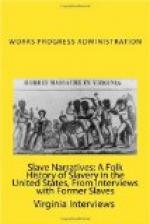“I have known the time in the southern part of this state when if you wanted to give an entertainment you would have to ask the white folks. Didn’t know no better. For years and years, most of the niggers just stayed with the white folks. Didn’t want to leave them. Just took what they give ’em and didn’t ask for nothing different.
“If I had known forty years ago what I know now!
First Negro Doctor in Tulip, Arkansas
“The first Negro doctor we ever seen come from Little Rock down to Tulip, Arkansas. We were all excited. There were plenty of people who didn’t have a doctor living with twenty miles of them. When I was fourteen years old, I was secretary of a conference.
Schooling
“What little I know, an old white woman taught me. I started to school under this old woman because there weren’t any colored teachers. There wasn’t any school at Tulip where I lived. This old lady just wanted to help. I went to her about seven years. She taught us a little every year—’specially in the summer time. She was high class—a high class Christian woman—belonged to the Presbyterian church. Her name was Mrs. Gentry Wiley.
“I went to school to Scipio Jones once. Then they opened a public school at Tulip and J.C. Smith taught there two years in the summer time. Then Lula Baily taught there one year. She didn’t know no more than I did. Then Scipio came. He was there for a while. I don’t remember just how long.
“After that I went to Pine Bluff. The County Judge at that time had the right to name a student from each district. I was appointed and went up there in ’82 and ’83 from my district. It took about eight years to finish Branch Normal at that time. I stayed there two years. I roomed with old man John Young.
“You couldn’t go to school without paying unless you were sent by the Board. We lived in the country and I would go home in the winter and study in the summer. Professor J.C. Corbin was principal of the Pine Bluff Branch Normal at that time. Dr. A.H. Hill, Professor Booker, and quite a number of the people we consider distinguished were in school then. They finished, but I didn’t. I had to go to my mother because she was ill. I don’t claim to have no schooling at all.
“Forty Acres and a Mule”
“My mother received forty acres of land when freedom came. Her master gave it to her. She was given forty acres of land and a colt. There is no more to tell about that. It was just that way—a gift of forty acres of land and a colt from her former master.




